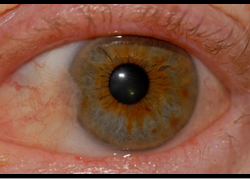 What is Pterygium?
What is Pterygium?
A pterygium is a benign elevated, triangular growth of the conjunctiva on to the cornea.
Because a pterygium resembles tissue or film growing over the eye, a person who has one may become concerned about personal appearance.
As with pinguecula, prolonged exposure to ultraviolet light from the sun may play a role in the formation of pterygia.
| • Redness |
| • Irritation |
| • Tearing |
| • Difficulty with contact lens wear |
| • Decrease in vision |
How a Pterygium Is treated?
Treatment depends on the pterygium's size and the symptoms it causes. If a pterygium is small but becomes inflamed, your eye doctor may prescribe artificial tears or possibly a mild steroid eye drop to reduce swelling and redness. The only way to get rid of the lesion is surgical removal. The surgical removal of a pterygium is done in an operating room setup under local anesthetic as a day procedure.
Unfortunately, pterygia often return after surgical removal.To prevent regrowth after the pterygium is surgically removed, your eye surgeon may suture or glue a piece of surface eye tissue onto the affected area. This method, called autologous conjunctival autografting, has been shown to safely and effectively reduce the risk of pterygium recurrence.
A drug that slows metabolic processes (antimetabolite) contributing to tissue growth, such as mitomycin, may be applied topically.
After removal of the pterygium, steroid eye drops may be used for several weeks to decrease swelling and prevent regrowth.
© Aggarwal Eye Hospital |
Site designed by Rainbow Web |